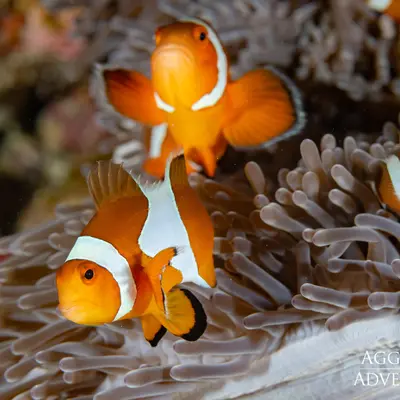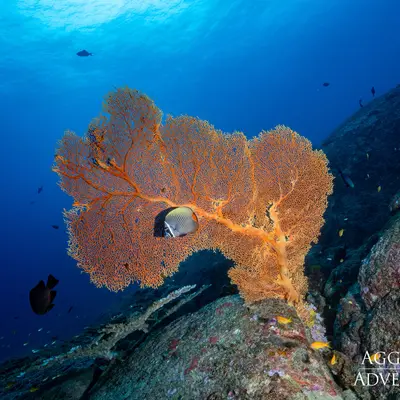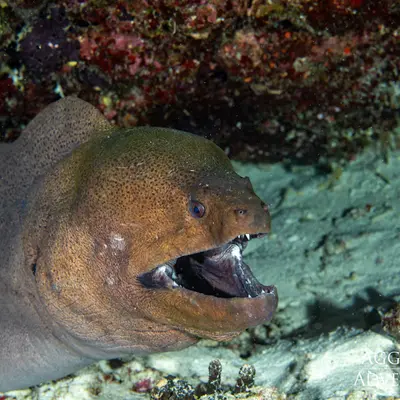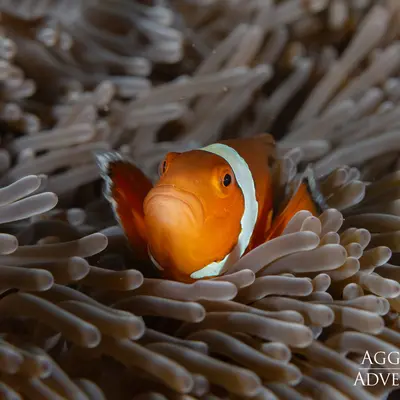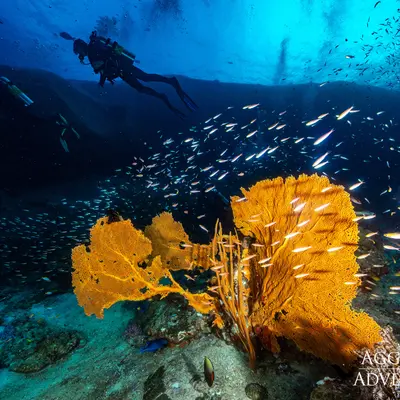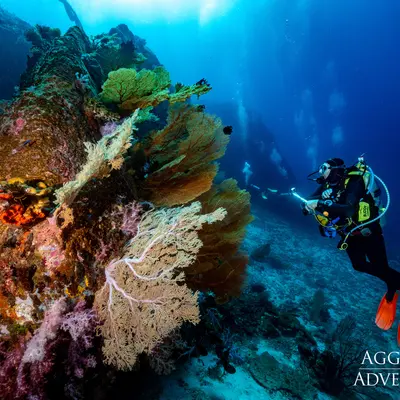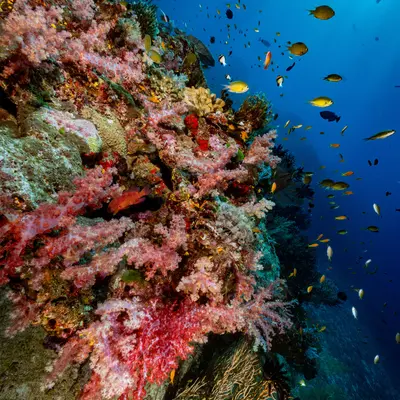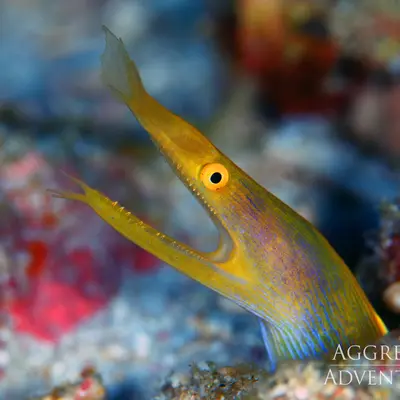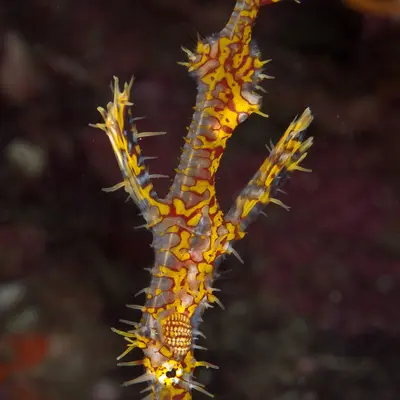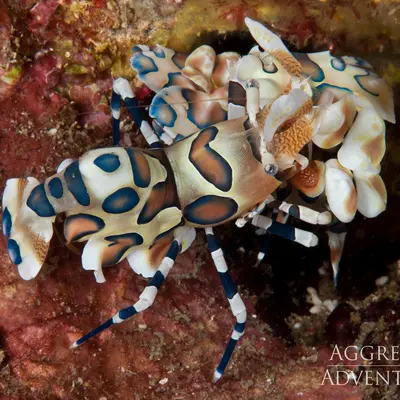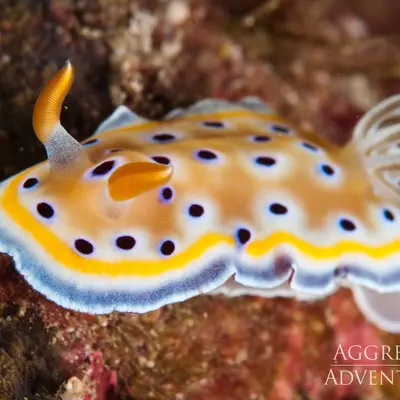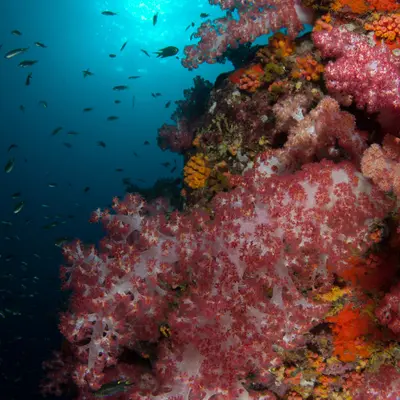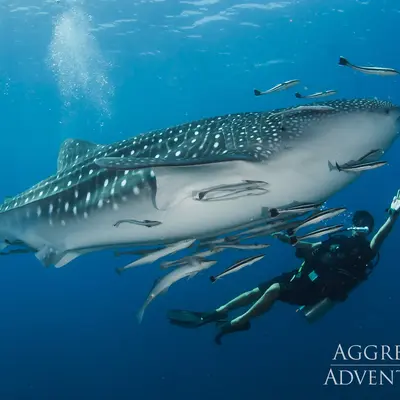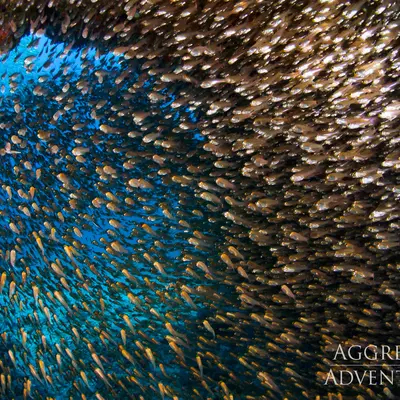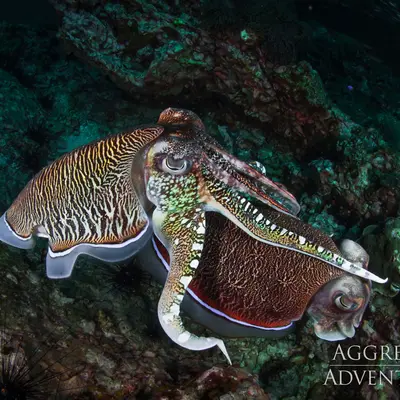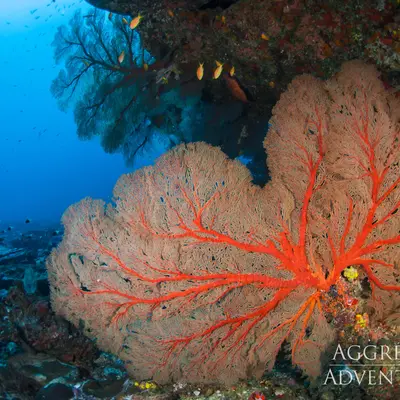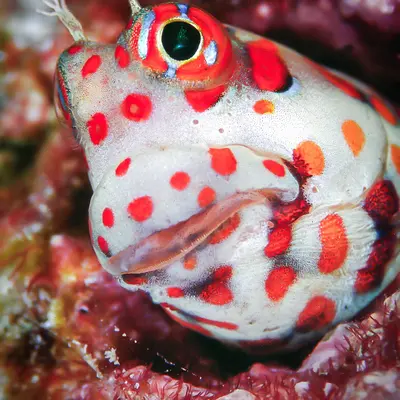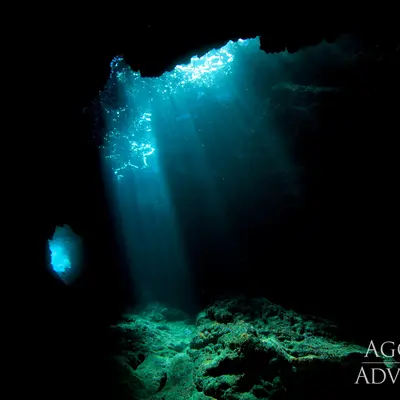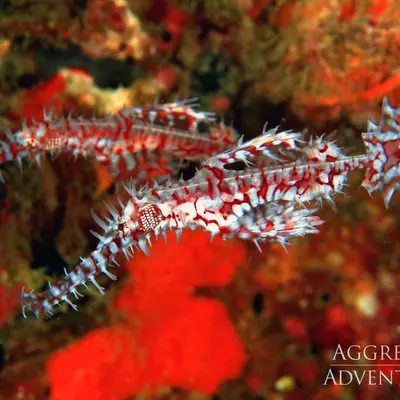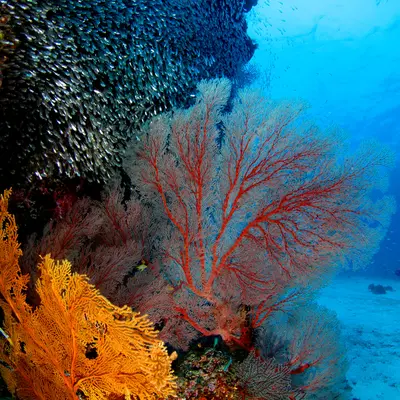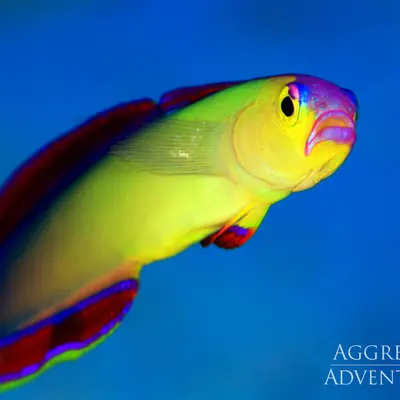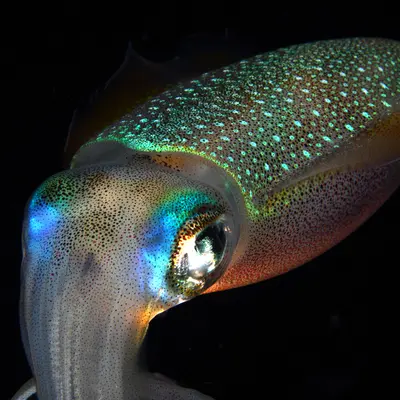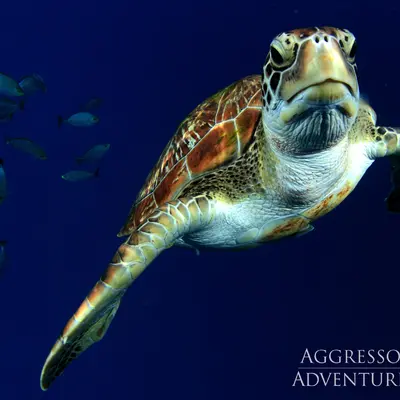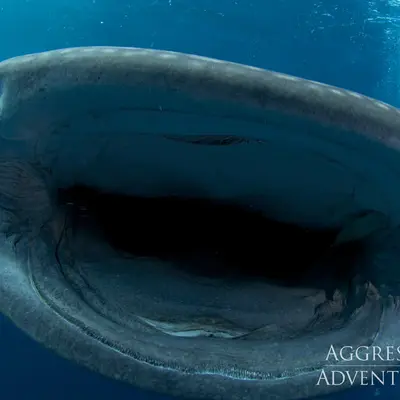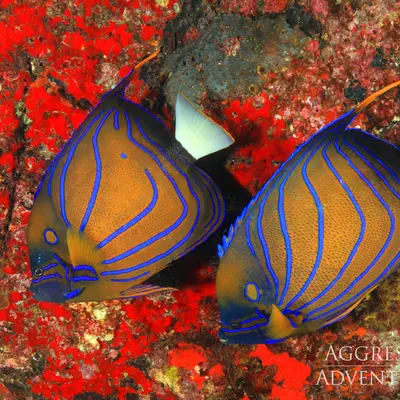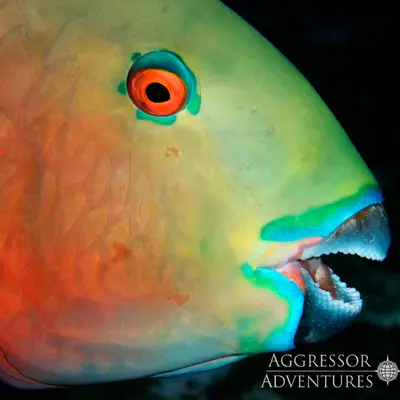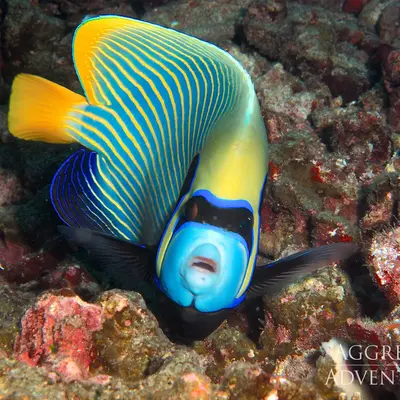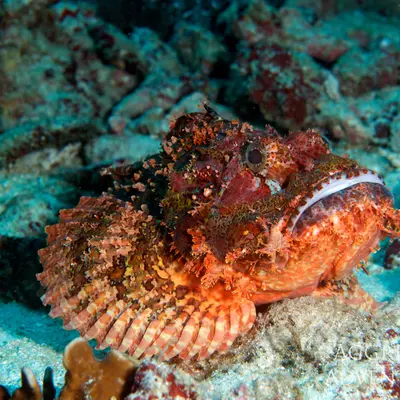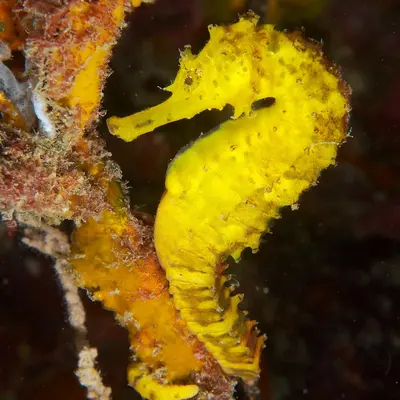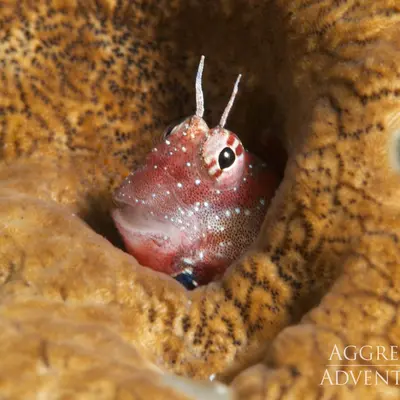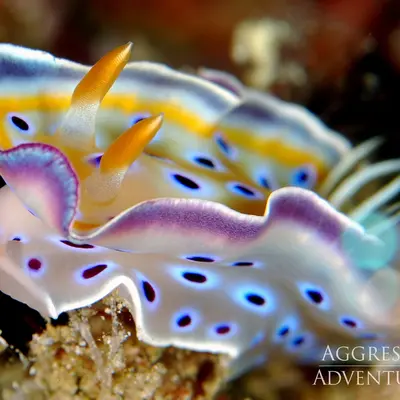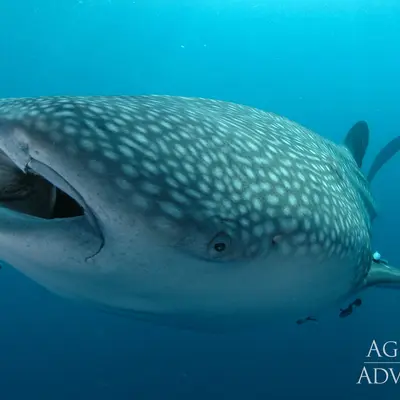The two routes of the Thailand Aggressor lead through the northern and southern parts of the Andaman Sea - including the famous Similan Islands. Divers can expect colourful reefs, steep walls with lush coral growth and fascinating marine life such as manta rays, leopard sharks, silvertip reef sharks, many other tropical species and, with a bit of luck, a whale shark. Up to five exciting dives are possible per day, including spectacular night dives.
The spacious dive deck is perfectly organised and offers individual equipment stations, rinsing basins and camera tables to make preparation for the dives as pleasant and efficient as possible.
This website uses Google Maps to embed map material. Please note that your personal data may be collected in the process. To view the Google Maps map, please agree that it is loaded from the Google server.
The M/V Thailand Aggressor is a 35 metre long top-class liveaboard that offers year-round diving trips in the Andaman Sea. There is room for up to 16 guests on board, accommodated in eight comfortable cabins. Each cabin has its own bathroom with shower, plenty of storage space, fresh towels, hairdryer, TV with media player and individually adjustable air conditioning - for a pleasant stay at sea.
The spacious dining room on the upper deck invites you to enjoy culinary delights, with a selection of Western cuisine and authentic Thai specialities. Soft drinks, iced tea, beer and wine are included in the price. For relaxing hours, the ship offers an open lounge, a sun deck with whirlpool, deckchairs, bar service and music via a CD/stereo system.
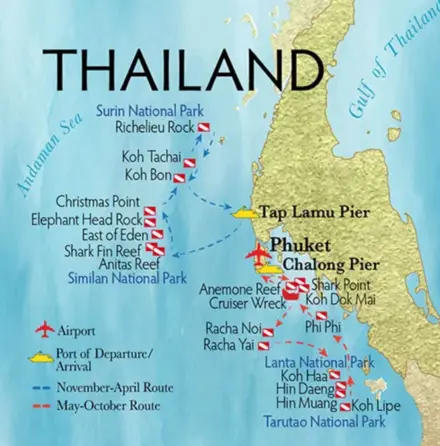
Thailand
is known as "The Land of Smiles" for its warm and friendly people. This island paradise lies just 8 degrees north of the equator and enjoys a tropical climate all year round. For divers, the real treasures of the Andaman Sea are to be found at famous sites such as the Similan Islands and Richelieu Rock, where the warm, clear waters attract large schools of tropical fish, manta rays and awe-inspiring whale sharks. The abundance of aquatic life will delight underwater photographers and marine explorers when diving from a liveaboard in Thailand.
Southern Andaman Islands dive sites: Koh 5 - Lepe - Hin Mung Hin dang - Phi Phi - Anemone Reef
- KOH HAA-LAGUNE - Koh Haa No.2 and No.4
Located in the centre of the Koh Haa group, the lagoon is a 16-foot (5m) deep area surrounded by two small limestone towers (Koh Haa No. 2 and No. 4) to the east and Koh Haa No. 3 to the west. The southern tower, covered with colourful soft corals, giant sea fans, black corals, anemone patches and orange cup corals, forms the southern side of the islands, with the outer sandy bottom at a depth of about 80 feet (24 m). Several rocks are scattered beyond the wall where divers can find snappers, and you'll find hard corals scattered throughout the sandy, sloping area that connects the two islands. The North Tower is pretty similar to the South, except things are on a larger scale.
Koh Haa No.3, a long island to the west of the lagoon. It's also another good dive site, but it's less famous than the two towers. This site is perfect for macro lovers. Due to the nature of the limestone rocks, there are many cracks and crevices along the wall that provide shelter for many small creatures such as shrimps and crabs. Take a closer look at a sea fan and you may find elaborate ghost pipefish and cowries camouflaged among the fronds. Harlequin shrimps and sea moths have sometimes been spotted between the two islands. Many species of nudibranchs make their home on the wall, and lobsters and squid can also be found here. - KOH HAA - NEUA - The Chimney, Koh Haa No.1
Koh Haa-Neua is the northernmost island of the Koh Haa group. This island is surrounded by reefs, on the north coast there is a wall covered with soft corals, sea fans and barrel sponges. A hard coral reef slope stretches from the south-east side to the east side of this island. The maximum depth at Koh Haa-Neua is 80 - 100 ft (25 - 30 m).
The most popular dive site on this island is located on the south side and is characterised by stunning ledges covered in dense growths of southern coral and sea fans that create a dazzling swim-through. At 50 - 60 ft (16 - 18 m) there is a grotto that leads to a chimney-like vertical hole - another highlight of this dive site. This chimney has two exits at a depth of 15 ft (5 m). Kuhl's stingrays, moray eels, scorpion fish and puffer fish are common sightings. Leopard sharks have also been spotted in the sand beyond the reef. Divers should also take the time to explore crevices - you may find ornate ghost pipefish or even rare species such as the tigertail seahorse. Striking harlequin shrimps have also been found in the area. - KOH HAA - YAI - The twin cathedral
The largest of the Haa Islands is Koh Haa Yai. It is characterised by a cliff that runs perpendicular to sea level and extends from above the water to a depth of up to 30 m (100 ft). Koh Haa Yai is surrounded by reefs, and the most famous dive site is the rock wall on the south side of the island, which ends in a sandy bottom at a depth of 80 - 100 ft (25-30 m) and is covered with a variety of soft corals, sea fans and stony corals.
There are two underwater caves on the south-east side. The entrance to the first cave is at a depth of 40 ft (12 m). As this cave becomes narrower with increasing depth, cave entry is not recommended unless divers are certified for cave diving. The second cave is a shallow cave and is located to the east of the first. The entrance is divided into two parts by a vertical ledge, but the rest of the cave is spacious and well lit. The hall height of the cave is 7 - 10 ft (2-3 m). above sea level, so it is possible to swim to the surface from the cave. This cave is also known as "The Cathedral" because of the blue light that is reflected from the surface. The outside of the cave is covered with soft corals, sea whips and ledges and ends in a sandy bottom at a depth of 90 - 100 ft (28-30 m). Leopard sharks and cow stingrays are common on the sandy bottom. Juvenile lobsters and a variety of nudibranchs can be seen in the crevices of the cliff, especially at the mouth of the cave. If you look closely, you can also find ghost pipefish camouflaging themselves between sea fans or soft corals. Schools of octopus and yellowtail barracuda are usually seen near the surface near the cave entrance, the reflection of the school of copper sweepers can be seen if you shine a light into the cave. Hawksbill turtles have also been spotted in the area. - Hin Daeng
If Richelieu Rock is the best dive site in the northern Andaman region, then Hin Daeng and Hin Muang, the striking twin rocks alone in the open sea, are undoubtedly the best in the southern Andaman region. Hin Daeng means "red rock" in Thai and is covered with red soft corals that make the rock appear red. Only three small pinnacles are visible from the surface, but once underwater, the huge shape of Hin Daeng extends 100-130 feet (30-40 metres) into the depths before reaching the sandy bottom.
A long wall of soft corals, sea fans and black corals stretches from the west to the south side of Hin Daeng, reaching the sandy bottom 130-165 feet (40-50 metres) underwater. The east and north-east sides, on the other hand, have a reef slope with pinnacles and hard corals. The contour slopes down to the sand to a depth of about 35 to 40 metres (115 - 130 ft). Divers can also swim across the large channel on the north side of Hin Daeng, which leads to the west side.
The variety of marine life ranges from large pelagic fish such as manta rays and whale sharks to a rich variety of nudibranchs. Manta rays in small groups of 3-4 are often spotted in Hin Daeng and whale sharks are also frequently sighted, especially during the high season (Feb-Apr) when they stay in these feeding grounds for long periods of time. Leopard sharks are often seen resting in the sand during the day and grey reef sharks have also been reported. You may even see large fish such as barracudas or moray eels hunting. On the way back to the rock face, you may also find an abundance of macro creatures such as ghost pipefish, harlequin shrimp, longnose hawkfish and nudibranchs. - Hin Muang
The twin outcrops to the west of Hin Daeng are known as Hin Muang, which means "purple rock" in Thai. The outcrops are completely underwater and covered with purple soft corals, hence the name of the site. The outcrops are long and narrow and resemble loaves of bread. There are several pinnacles, with drop-offs ranging from 150 to 200 feet (45 to 60 metres) to the sandy bottom. The drop-offs around Hin Muang are rich in marine life and covered in soft corals, gorgonian sea fans and black corals.
Hin Muang is an oasis in the vastness of the southern Andaman Sea, attracting an abundance of pelagic visitors such as manta rays and whale sharks, especially during the peak plankton bloom period in late March and April. In addition, schools of rainbow runners, barracudas, snappers, batfish and many other tropical reef inhabitants surround the pinnacles of Hin Muang, while other fish such as groupers, snappers and giant moray eels lurk in the many crevices. In sandy areas, divers often encounter leopard sharks, as well as grey reef sharks and common rays. The area is also rich in macro life, such as ghost pipefish, harlequin shrimps and an unimaginable variety of nudibranchs just waiting to be discovered. If you take a peek between the tangled branches of a black coral forest, you might spot a long-nosed hawkfish. - Bida Nok
Koh Bida Nok has a remarkably dramatic underwater topography and is characterised by steep drop-offs, caves, swim-throughs and underwater rocks. It's no wonder that Koh Bida Nok and its sister island Koh Bida Nai are two of the most popular dive sites on the Phi Phi Islands. On the south side of the island is a small underwater bay consisting of a reef slope and a rocky bottom that starts at 20 ft (6 m) and ends in a sandy bottom at 65 ft (20 m). A vertical swim-through on the south-west side of the island, beautifully lit by surface lights, is not to be missed. Outcrops of varying sizes are scattered along the west coast and drop off to a depth of 26-28 m (85 - 90 ft), while the east coast is a reef slope with a mixture of hard and soft corals and small outcrops.
Leopard sharks usually lie on the sandy bottom, and blacktip reef sharks can sometimes be found along the reef line. Kuhl's stingrays are common in the area and are on the lookout for small bamboo sharks hiding in crevices. Look into the blue beyond the reef and you may also see schools of pickhandle barracuda and bigeye snapper. Along the reef you will also find a variety of colourful reef fish, such as pufferfish, porcupinefish and lionfish. Macro enthusiasts should also look out for ornate ghost needles and seahorses. - Bida Nai
Like its sister island, Koh Bida Nai has an amazing topography with underwater crevices, huge boulders and fields of antler reefs. A gradual reef slope stretches across the south and west coast of the island, starting at a depth of 15-30 feet (5-10 metres) and consisting of stony corals such as pore corals, table corals and staghorn corals. There are also some large boulders and a swim-through on the south side. The east side of the island is a large sandy slope with fields of staghorn coral. Divers can find leopard sharks snoozing on the island or swim to the large pinnacle beyond the reef to see the large school of mackerel, barracuda and other fish. The upper part of the pinnacle is about 14-18 metres (45 - 60 ft) above the surface and extends to a depth of at least 30 metres.
The topography on the north side of the island, on the other hand, consists mainly of stunning rocks and cliffs, with the walls dropping vertically to a depth of 65 - 80 ft (20-25 m) before hitting the sandy bottom. In this section there are soft corals, sea fans and many huge barrel sponges. Leopard sharks are quite common in this area, especially on the east side of the island. Blacktip reef sharks and whitetip reef sharks are known to surface in the area and not to scare bamboo sharks, which can hide under rocks or in cracks. Divers may even spot a turtle or two.
Schools of barracuda and mackerel are often spotted near the eastern peak, as well as snapper, mackerel and other pelagic species. Divers can also see sea snakes, octopus and Kuhl stingrays. Macro species such as ghost pipefish, nudibranchs and porcelain crabs are also frequently sighted. - King Cruiser
King Cruiser was a car and passenger ferry on the route from Phuket to Phi Phi Island that sank on 4 May 1997 after hitting a submerged rock called Anemone Reef on its way to Phi Phi Island. Fortunately, there were no fatalities in the incident. Fortunately, the wreck has settled in an upright position on the sandy bottom and remains relatively close to Anemone Reef and Shark Point and lies 25-27 kilometres east of Chalong Bay with a north-south orientation. The depth is about 105 feet (32 m) at the sandy bottom and about 45-50 feet (14-15 m) at the top.
The wreck is 280 feet (85 m) long and 82 feet (25 m) wide, with four decks with large passageways and window holes that divers can use to gain easy access to explore the spacious interior. However, some parts of the wreck have deteriorated noticeably, and in mid-2003 the upper deck at the stern collapsed into the centre section, so the wreck is now considered unsafe for entry. Divers can explore the passenger deck at a depth of around 60 to 75 feet (18 to 22 metres), while others are more interested in exploring the remains of the wheelhouse on the top level. For those interested in shark sightings: A nurse shark has been seen sleeping near the remains of the propellers on the bottom, and a grey bamboo shark has been spotted at the opening at about mid-level at the stern. Hundreds of scorpionfish are usually camouflaged almost everywhere on the barnacles and rusting steel of the wreck. Divers are therefore advised to be careful if they absolutely need to hold on to or touch any part of the wreck. Along the stern, hovering lionfish are a common sight, and divers may find themselves surrounded by schools of mackerel, snapper, rabbitfish and fusiliers at the top of the wreck. Other creatures that can be spotted on the wreck include some species of nudibranchs, eels, crabs and lobsters. Occasionally you may even come across a giant barracuda or hawksbill turtle. - Shark Point - Hin Mu Sang
Named after the frequent sightings of leopard sharks in the area. This dive site, called Hin Mu Sang by the locals, consists of 3 main pinnacles that lie in an almost north-south orientated formation, with the axis tilted slightly to the east. These pinnacles are usually labelled by their numbers - the northernmost peak is "number 1" and so on.
This site has the greatest variety of fish and coral in the area. Each pinnacle is about 10-15 m (35-50 ft) away from the others and has areas covered with striking purple and pink soft corals, sea fans from 50 cm to a human size, and beds of table coral, staghorn coral and coral heads. Pinnacle No.1 is the only one visible from the surface and has a small lighthouse with a surprisingly large submerged section. The summit of No. 2 is 15-25 feet (5-7 m) below the surface and the summit of No. 3 is 50 feet (15 m) underwater. The sandy bottom is about 40 feet (12 m) deep on the north side, and the top extends a little to the northwest to a depth of about 80 feet (24 m) and shallower, to a depth of about 50 to 75 feet (15-22 m) on the south and east sides, with scattered rock all around.
The dive usually starts at one peak and ends at the next peak, with the direction depending on the current. As there is a wide variety of marine life here, it is almost impossible to cover all three pinnacles in one dive and do the site justice. The third pinnacle is rarely visited as the average depth is quite deep. For a more enjoyable one-hour dive, most people dive from No. 1 to No. 2 or vice versa. Some species of marine life that inhabit the area are scorpionfish, lionfish, pufferfish, blue-ringed angelfish, snapper, grouper and some species of eels. Look out on the rocks and among the corals for colourful nudibranchs, dancing Durban shrimps and also cute little juvenile fish such as the cube boxfish and harlequin sweetlips. Above the reef there are also schools of fish such as the yellowtail barracuda, the yellowline snapper and the soldierfish.
Shark Point is the right place for divers who want to spot big fish. There is always a good chance of finding leopard sharks lying on the bottom next to the pinnacle, and grey bamboo sharks also hide under coral heads or in small crevices. However, sharks are not the only highlight of the site - tiger tail seahorses and ornate ghost pipefish often provide a pleasant surprise among the sea fans and corals. - Anemone reef - Hin Jom
Located about 25-27 km east of Chalong Bay, Anemone Reef is a submerged rocky outcrop whose top is about 5 m (15 ft) underwater, giving this dive site its Thai name "Hin Jom". The English name is similarly simple: sea anemones live in surprisingly dense populations in the shallows, offering an amazing view of the sea's own version of a living carpet.
The summit is orientated north-south, with a small, sloping channel near the southern part. The depth ranges from 15 to 80 feet (5 to 25 metres), and while there is a gentle slope to the sandy bottom on the east side, it is steeper on the west side. Due to the amount and variety of marine life living in the beautiful soft corals and sea fans that cover the top, Anemone Reef is the ideal location for nature courses and undoubtedly a favourite among photographers.
Anemonefish and clownfish are common, as are large schools of snappers that cloud the pinnacle. Shoals of yellowtail barracuda are also often seen circling the rock, along with groupers, oriental sweetlips, juvenile harlequin sweetlips, scorpionfish and soldierfish darting between corals, cracks and crevices. Leopard sharks, possible "escapees" from the famous dive sites nearby, can also swim by from time to time. Small creatures such as tiger-tailed seahorses are also occasionally seen here. In the shallows near the mooring line, a few ornate ghost pipefish and even an anglerfish have been spotted here.
Example of an itinerary
We strongly recommend travelling a few days earlier and visiting Bangkok. Transfers are free on the arrival/departure days of the charter at the following pick-up points.
Day 1:
Guests arriving at Phuket International Airport (HKT) on the day of the charter and host hotels will be picked up by a Thai Aggressor representative at the above times. If you are already on the island, you can make your way to the Thailand Aggressor docking at Chalong Pier to board at 6pm, or you can meet at one of the pick-up points listed below.
- Saturday 4pm: Phuket International Airport (HKT) for transfer to Chalong Pier.
- Saturday 16-16:45: Westin Siray Bay Resort & Spa to Chalong Pier.
The yacht leaves all ports on Saturday evening for its first night anchorage to prepare for diving the next morning.
Day 2 -7:
- Sunday to Friday afternoon; Andaman Sea; eat, sleep & dive
- The yacht will arrive back at Chalong Pier on Friday afternoon/early evening. The crew will organise a cocktail party and then dinner will be served on board.
Day 8: Check-out is at 8:00 am on Saturday morning.
- Saturday 8am: Departure to Phuket International Airport (HKT).
- Saturday 8am: Departure to the guest hotels.
Marine life: Whale sharks, manta rays, leopard sharks, silvertip reef sharks, walls and reefs with over 500 species of hard and soft corals and abundant marine life.
The last dive takes place on the penultimate day of the trip. Divers are advised to wait 24 hours after the last dive before flying.
Sample itineraries and maps are for illustrative purposes only. The exact route and sites visited may change depending on local regulations, guest experience, weather and logistics and are at the captain's discretion.
Master cabin lower deck
- 1 double bed
- adjustable air conditioning
- En-suite bathroom
- max. 2 guests
Mastere cabin main deck
- 1 double bed
- adjustable air conditioning
- En-suite bathroom
- max. 2 guests
Deluxe cabin main deck
- 1 double or 2 single beds
- Adjustable air conditioning
- En-suite bathroom
- max. 2 guests
Includes VAT, airport transfers, soft drinks, tea & coffee, drinking water, wine with dinner, snacks, full board (all meals), dive packages, towels for use on deck, cabin towels, complimentary toiletries.
Required extras: National Park fees (95 USD per trip), visa and fees.
Optional extras: Travel insurance, diving insurance, tips, hotel transfers, regional flights, rental equipment, Nitrox course, diving courses, additional dives, snorkelling set.
Prices for rental equipment
Rental equipment is available on this ship. Please indicate on the booking form what you need. Details below of what is included and the additional prices.
- Regulator: 60 USD per trip
- BCD: 60 USD per trip
- Fins: 50 USD per trip
- Mask: 50 USD per trip
- Snorkelling set: 50 USD per trip
- Torch: 8 USD per day
- Dive computer: 60 USD per trip
- Full equipment (with: Regulator, BCD, fins, mask, snorkelling set, torch, dive computer): 175 USD per trip
- Wetsuit: 50 USD per trip
- The air temperatures are based on average values for Phuket and the surrounding area.
- Water temperatures vary throughout the year from around 28.5 °C in January and December to 30 °C from April to June.
- Rainfall in this region is seasonal, with higher values in the months of May to October.
The Andaman Sea is located in the south-west of Thailand and is part of the eastern Indian Ocean. It borders the Thai provinces:
- Phuket
- Krabi
- Phang Nga
- Trang
- Satun
Popular islands and dive sites in the Andaman Sea are:
- Similan Islands
- Koh Phi Phi
- Koh Lanta
- Richelieu Rock
- Hin Daeng / Hin Muang
The population
Several million people live in the neighbouring coastal regions, e.g. in:
- Phuket City
- Krabi
- Trang
The population consists mainly of Thais (ethnic Thai), but there are also
- Sea gypsy communities (Moken)
- Muslim minorities
- Burmese labour migrants
Religions
- Buddhism (majority religion in Thailand)
- Strong presence of Islam in southern Thailand (especially in coastal regions such as Satun and Trang)
- Smaller groups of Christians and Hindus
The Andaman Sea is considered a top destination for divers worldwide, offering intact coral reefs, great biodiversity, manta rays, whale sharks, wrecks and spectacular underwater landscapes.
Diving tourism provides:
- Direct jobs: Diving schools, guides, boat crews, shops
- Indirect jobs: hotels, restaurants, transport, handicrafts
Economic situation
- Economically, the coastal regions are heavily dependent on tourism, especially in Phuket and Krabi.
- Other important sectors: Fishing, agriculture (rubber, palm oil), small-scale trade.
- Diving and beach tourism provide high income, especially in the high season (Nov-April).
- There are economic disparities in more remote areas, despite growth in tourism.
Importance for Thailand
The region is one of the most important tourist areas in the country, contributing significantly to the strengthening of the national currency (baht) and employment in the south, with massive investment in infrastructure, disaster prevention and sustainable tourism following the 2004 tsunami.
Economic impact of the diving industry
While tourism has led to an increase in living standards in many coastal communities, there are also challenges such as coral bleaching, congestion due to mass tourism and plastic waste in the sea.
Why the Andaman Sea is a favourite destination for divers
- Diverse diving areas - from shallow coral gardens to deep-sea spots.
- Great biodiversity - e.g. whale sharks, manta rays, turtles, seahorses.
- Well-developed infrastructure - many certified diving centres, good accessibility.
- Seasonal highlights - e.g. whale shark season, liveaboard safaris to remote spots.
- Attractive combination of culture and nature - temples, jungle, beaches.
- Value for money - cheaper diving packages than in the Caribbean or Pacific.

